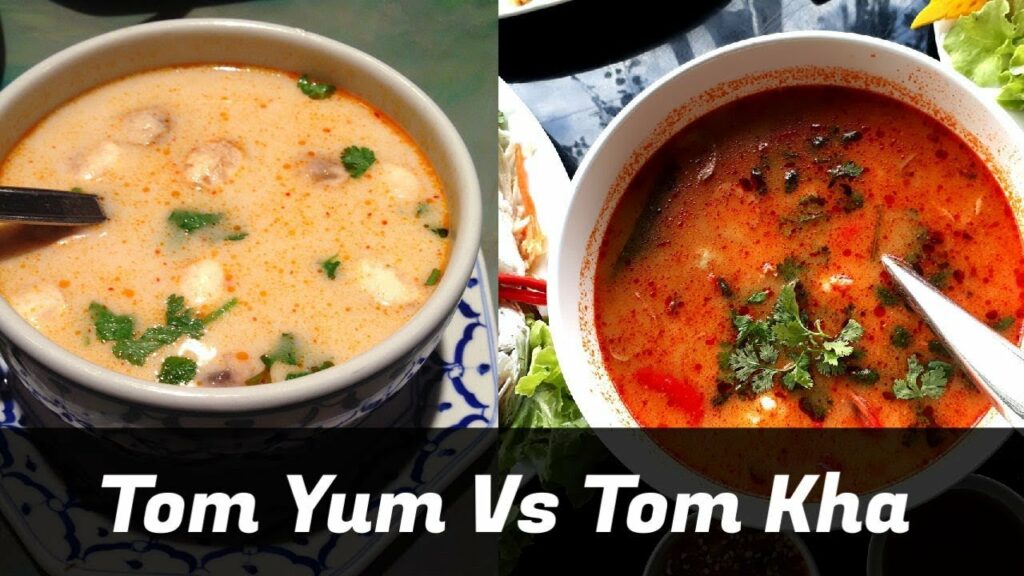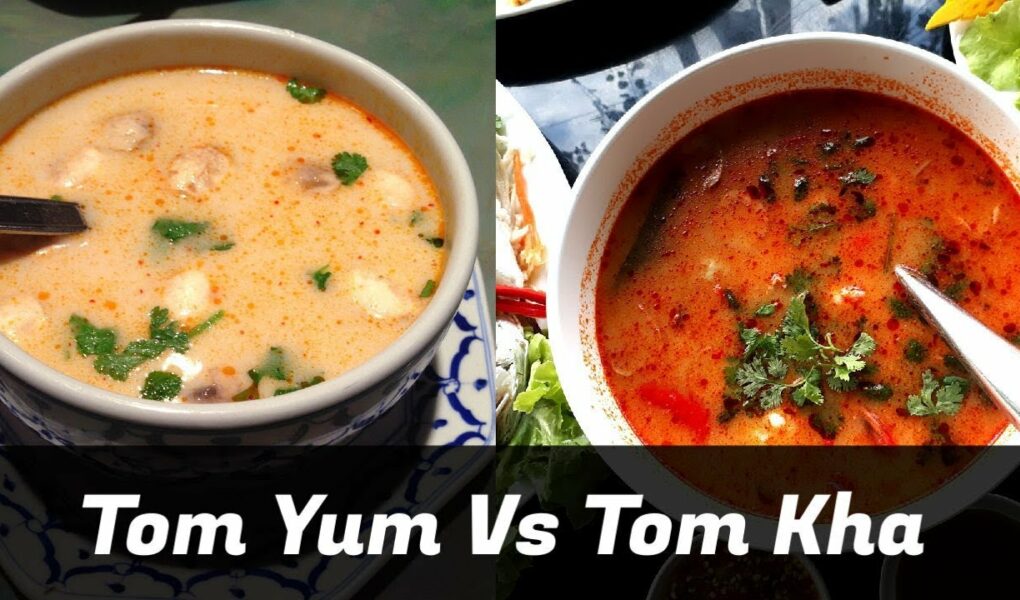Thai cuisine is renowned for its vibrant flavors, aromatic herbs, and bold spices. Among the many delightful dishes, two iconic soups often captivate the taste buds: Tom Yum and Tom Kha. While they may appear similar at first glance, there are distinct differences that set them apart.
In this article, we will be discussing TOm Ym vs Ton Kha and l explore the distinct characteristics, flavors, and key factors that differentiate Tom Yum and Tom Kha, two popular Thai soups.
Tom Yum Characteristics:

Tom Yum, a classic Thai soup, is known for its clear broth and vibrant flavors. The soup base is created by infusing a combination of lemongrass, galangal, kaffir lime leaves, chili peppers, lime juice, and fish sauce. The result is a broth that is clear and transparent, with a focus on creating a spicy taste experience. Tom Yum showcases a bold and intense flavor profile, with aromatic herbs and spices that create an invigorating and memorable taste.
Tom Kha Characteristics:

In contrast to the fiery nature of Tom Yum, Tom Kha, also known as Coconut Soup, offers a distinct departure. The soup base is created by incorporating coconut milk into the mixture, resulting in a creamy and opaque texture. Key ingredients include galangal, lemongrass, kaffir lime leaves, coconut milk, lime juice, and fish sauce. Tom Kha is known for its delicate and slightly sweet flavor profile, with the creaminess of coconut milk providing a smooth and comforting experience.
Also Read – Dragon Fruit vs Passion Fruit: What’s The Difference
Tom Yum vs. Tom Kha: Factors to Compare

Soup Base:
The soup bases of Tom Yum and Tom Kha differentiate them in appearance and texture. Tom Yum features a clear and transparent broth, while Tom Kha boasts a creamy and opaque consistency due to the inclusion of coconut milk. These contrasting soup bases contribute to the overall experience and visual appeal of each soup.
Taste:
The taste profiles of Tom Yum and Tom Kha exhibit a stark contrast. Tom Yum delivers a bold and spicy flavor with a tangy kick. The combination of chili peppers and lime juice provides an intense and zesty sensation. In contrast, Tom Kha offers a more subdued and delicate taste. The creaminess of coconut milk balances the flavors, resulting in a mild, creamy, and slightly sweet experience.
Ingredients:
The key ingredients used in Tom Yum and Tom Kha contribute to their distinct flavors. Tom Yum incorporates lemongrass, galangal, kaffir lime leaves, chili peppers, lime juice, and fish sauce. These ingredients create a vibrant and aromatic blend that defines the soup. Tom Kha, on the other hand, utilizes galangal, lemongrass, kaffir lime leaves, coconut milk, lime juice, and fish sauce. The addition of coconut milk imparts a creamy richness and subtle sweetness to the soup.
Appearance:
The appearance of Tom Yum and Tom Kha sets them apart visually. Tom Yum features a clear broth with visible herbs and chili flakes, giving it a vibrant and enticing look. On the other hand, Tom Kha boasts a creamy and opaque texture, thanks to the incorporation of coconut milk. The smooth appearance of Tom Kha adds to its allure.
Flavor Profile:
The flavor profiles of Tom Yum and Tom Kha are distinct and memorable. Tom Yum offers a bold, intense, and aromatic taste, showcasing the complexity of Thai spices and herbs. The combination of lemongrass, galangal, and chili peppers creates a fiery and invigorating experience. In contrast, Tom Kha presents a more subtle and well-balanced flavor profile. The creaminess of coconut milk, combined with the tanginess of lime juice, delivers a delicate and comforting taste.
Protein Options:
Both Tom Yum and Tom Kha offer a variety of protein options to suit different preferences. Tom Yum is commonly made with shrimp, chicken, or other meats. This allows for versatility in choosing the protein that best suits your taste. Similarly, Tom Kha is often prepared with chicken, seafood, or other meats. The seafood versions of Tom Kha are particularly popular, as they showcase the harmonious combination of flavors between the seafood and the soup base.
Nutrition:
In terms of nutrition, both soups have their merits. Tom Yum tends to be lower in calories and fat due to its clear broth and minimal use of coconut milk. It is a lighter option for those seeking a healthier choice. On the other hand, Tom Kha, with its inclusion of coconut milk, provides a creamier and more indulgent experience. While it may have slightly higher calorie and fat content, it offers the richness and satisfaction of coconut milk.
Serving and Pairing:
Tom Yum and Tom Kha are traditionally served and paired with different accompaniments and dishes. Tom Yum is often served with steamed rice or rice noodles, allowing you to enjoy the flavorful broth alongside the grains. It pairs well with stir-fried dishes or grilled meats, creating a balance between the spicy soup and savory main dishes.
Tom Kha, on the other hand, is usually served with steamed rice, enhancing the creamy and delicate flavors of the soup. It matches well with seafood dishes or curry-based meals, where the combination of flavors creates a harmonious culinary experience.
Also Read – Gala vs. Fuji Apples: Exploring the Differences and Delights
What Are the Similarities between Tom Yum and Tom Kha?
While Tom Yum and Tom Kha have distinct characteristics, there are some similarities worth noting. Both soups use common ingredients such as lemongrass, kaffir lime leaves, and lime juice, which are fundamental elements of Thai cuisine. They are representative of the bold and vibrant flavors found in Thai cooking, highlighting the use of aromatic herbs and spices that are synonymous with Thai cuisine.
So, What’s the Difference between Tom Yum vs. Tom Kha?
The differences between Tom Yum and Tom Kha lie in their soup bases, taste profiles, key ingredients, appearance, protein options, and overall experience. Tom Yum offers a clear and spicy broth with bold and intense flavors, while Tom Kha provides a creamy and subtly sweet experience, thanks to the inclusion of coconut milk. Each soup has its own unique characteristics that make it stand out and cater to different taste preferences.
Also Read – Red vs. White Dragon Fruit: Exploring the Differences?
Conclusion:
Exploring the world of Thai cuisine would be incomplete without indulging in the delightful duo of Tom Yum and Tom Kha. These iconic soups showcase the rich flavors and unique characteristics of Thai culinary traditions. Whether you crave the bold spiciness of Tom Yum or the comforting creaminess of Tom Kha, both soups offer a delightful journey for your taste buds.
Understanding the factors that differentiate Tom Yum and Tom Kha enhances our appreciation for the diverse flavors of Thai cuisine. So, savor each spoonful, embrace the contrasts, and let the flavors transport you to the vibrant streets of Thailand.




